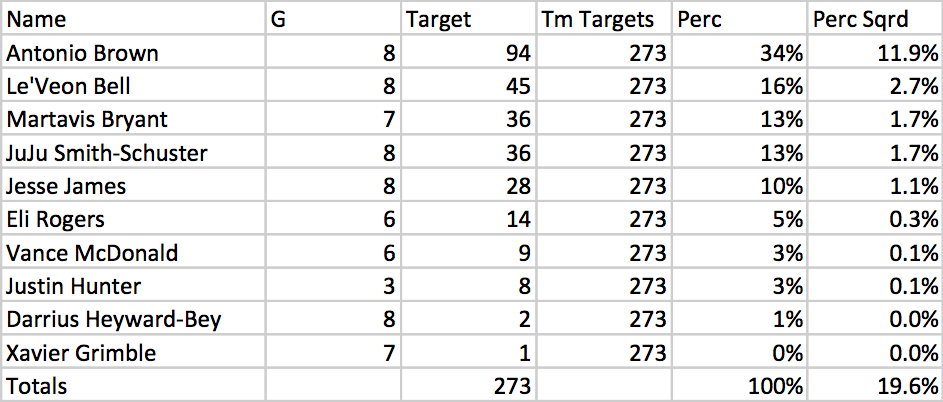In the summer, I wrote an article describing the increased emphasis on spreading the ball around in team passing games. Through nine weeks of the 2017 season, which teams have the most and least concentrated passing games?
One way to measures this is to calculate the percentage of team targets had by every player on each team, square that result, and sum those squared results to get a team grade. Let’s use the Steelers as an example. Pittsburgh has 273 team targets this year, and star receiver Antonio Brown has seen 94, or 34%, of those targets. The square of 34% is 11.9%; perform those calculations for every Steelers who has a target this year, and the sum of those squares is 19.6%.
That 19.6% number is the highest in the NFL this season, at least through nine weeks. It’s followed by the Texans and Cowboys at 18%, as both Texas teams rely heavily on their star wide receivers, DeAndre Hopkins and Dez Bryant. The Panthers, Bengals, and Dolphins are the next three teams, and all three have below-average passing games. I’m loathe to fault A.J. Green for Cincinnati’s struggles, but Carolina and Miami are putting huge target numbers on unproductive players: Jarvis Landry leads the NFL in targets per game and ranks 4th in percentage of team targets despite averaging an anemic 7.7 yards per catch on a 64.4% catch rate. Christian McCaffrey has received 25% of all Panthers targets, but he’s only averaging 7.5 yards per reception (and has a 75.0% catch rate).
The five teams with the least concentrated passing games all have bad passing offenses: the 49ers, Giants, Bears, Ravens, and Browns. The fact that those passing attacks have spread the football around may be more to do with injuries and poor receivers than design; I am sure the Giants would love to have instead thrown 90 passes to Odell Beckham this year. Cleveland, for example, ranks dead last in both concentration index and ANY/A this year: that’s because the Browns simply have nobody to throw it to.
The table below shows, for each passing attack, its number of targets, its concentration index, and its Relative ANY/A — that is, the amount of ANY/A above or below average.
The Browns are 32nd in ANY/A and 32nd in concentration index; the Ravens are 31st in ANY/A and 31st in concentration index. There’s definitely a correlation between the two statistics (in fact, the correlation coefficient is 0.43, indicating a relatively strong positive connection), but there are also outliers.
Kirk Cousins and the Redskins are one. Washington ranks 7th in ANY/A, but just 26th in concentration index, the only team in the top quarter of ANY/A and bottom quarter of concentration index (the Dolphins and Panthers are in the reverse categories). Cousins has done an impressive job of spreading the football around: Chris Thompson actually leads the team in targets with 46, but six other players (Jamison Crowder, Terrelle Pryor, Jordan Reed, Ryan Grant, Vernon Davis, and Josh Doctson) have at least 22 targets. Washington has a top-8 passing attack with its leaders in receiving yards being a backup running back, a 33-year-old tight end, and Jamison Crowder and Ryan Grant. Meanwhile, higher profile names like Pryor, Reed, and Doctson rank 5-6-7 on the team in receiving yards.
For Jared Goff and the Rams, a similar story has unfolded. Five players — WR Robert Woods, WR Cooper Kupp, RB Todd Gurley, WR Sammy Watkins, and TE Tyler Higbee — have between 29 and 49 targets, with no player having yet hit the 50-target threshold. That arguably makes Jared Goff’s work this year even more impressive.
And then there is Alex Smith and the Chiefs. On the surface, it might feel like everything in Kansas City is going through Travis Kelce, Tyreek Hill, or Kareem Hunt. And while those three have about two-thirds of the team’s receiving yards, they “only” have accounted for 58% of Kansas City targets. That means 42% of the team’s passes are still going to the other, less-accomplished members of the Chiefs dominant passing attack.

